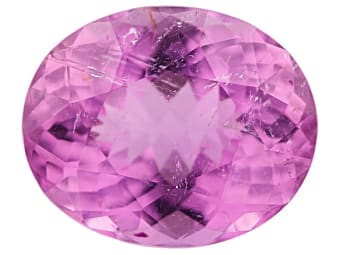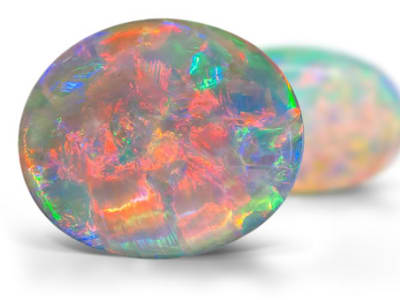What is opal?
Opal, the birthstone for October, is is often regarded as the Queen of Gemstones - and there’s no question as to why. Often compared to fireworks and galaxies, opal has a unique rainbow of color that leaves other gems envious. Want to learn more about the light of the world? Here are some interesting facts that make October's birthstone just a little more special.
Opal FAQ
Here are answers to more frequently asked questions about October's birthstone:
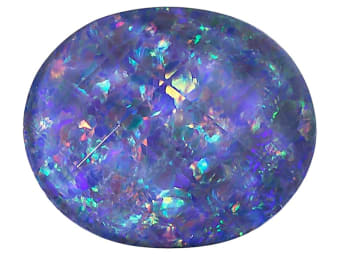
What is opal’s history?
The first known opal relics were found in a cave in Kenya. However, it is believed by geologists that these opals originated in Ethiopia around 4000 BC. Interestingly, it wasn't until the 1990s when miners rediscovered Ethiopian opals all over again despite the age of this region's relics.
Empires and Opals
The Romans were the first empire to sell opal on the market. Mark Anthony (a famous Roman general) once bought an opal gem because it reminded him of his lover - Cleopatra, the last pharaoh of Egypt. He claimed that they enjoyed gazing at the stars together, and the opal had a galaxy look that reminded him of his distant love.
October's birthstones have also been used in the crowns of royals for centuries - including France. In fact, Napoleon even gave his Empress Josephine a famous opal called "The Burning of Troy". Unfortunately, the opal was either hidden or destroyed after Josephine's death.
Opal Trade
Opal has made its appearance in many cultures throughout history. Historically, Hungry was the opal capital of the world, but its supply was depleted by the end of the 18th century. In the 1800s, Australia began to mine opal more and more to meet consumers' demand and quickly became the leader of opal mining - owning over 90% of the opal market share.
How is opal formed?
Opal is formed by the rains. As rainwater runs down through the earth, it collects silica from sandstone and carries it into the cracks and voids of rocks. These voids are usually caused by natural faults or decomposing fossils. As the water from the rains evaporates, it leaves behind the collected silica deposit, which forms into a gel. Over millions of years, this silica gel hardens and forms the opal gemstones. Rinse and repeat the process over millions of years, and you get gem sized opals.

Where is opal found?
October's birthstone can be found worldwide, but more than 90% of the world's opal supply comes from Australia. Black opal, the rarest of all opals, is exclusively mined in Lightning Ridge, Australia. White opals, a more common opal, is found in South Australia. The boulder and matrix opals are both found in Queensland, Australia. It's no wonder that the opal is the national gemstone of Australia!
But opal can be found in other parts of the world as well. For instance, in the 1990s, opal was discovered in Ethiopia and now it is mined in that country. Although there isn't nearly as much opal in Ethiopia as Australia, Ethiopian opals are some of the world's largest carat sizes. To retrieve these beautiful gems, a 65 ft (20 meters) deep hole is cut into the ground using a jackhammer. The diameter of the hole is only 3 ft (1 meter) across. Miners climb down into the holes with a ladder to find opals by hand. It's truly a game of luck!
What are the basic types of opal?
Black opal:
Black opal is the rarest of the opals. This beautiful gem is only found in Australia and is frequently mined in Lightning Ridge. Despite its name, the stone is not entirely black - it's still vibrant with color. It is called black opal because the body tone is dark compared to the more common, white opal.
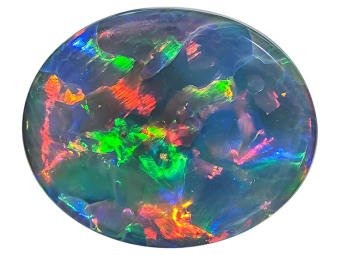
White opal:
White opal, also known as milky opal, has light body tones. Still mined in Australia, this gemstone is much more common compared to its cousin. This gem doesn't show as much color as the black opal, but can still be found in every color of the rainbow.
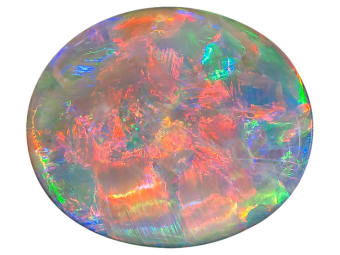
Boulder opal:
Boulder opal forms in the cavities of ironstone boulders in Queensland, Australia. These gems are dark and full of beautiful colors. This gem has been found as small as a pea to as big as a car. And the best part? Boulder opals can give off every color of the rainbow in just one gem - that's seven colors.
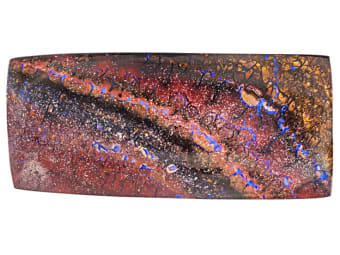
Did you know... The water content of opal averages around 5 percent but can get as high as 20 percent?
Opal Gemstone Properties
For more facts and information about the characteristics of the October birthstone, check out the Opal Gemopedia page.
Physical Properties of Opal
October’s birthstone, opal, only ranks at 5 - 6.5 on Mohs Hardness Scale, making this colorful gem pretty delicate. With the right care, they will last a lifetime. Just be careful while wearing an opal to avoid scratching it.
Opal is a very porous rock, so when you clean it, do not submerge your opal jewelry in water. This can cause damage. Instead, use a damp cloth to clean your gemstone. October’s opal luster is classed as vitreous (glassy/smooth) or resinous.
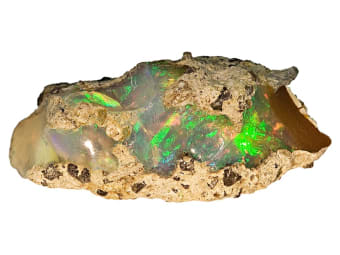
What is the spiritual meaning of October’s birthstone?
Depending on where you are in the world, the spiritual meaning of opal changes. In Ancient Rome, they called opal 'opalus,' which means 'precious stone' and considered opals as symbols of love and hope. In fact, Europeans have long considered the opal a symbol of hope, purity and truth.
Spiritual legends surround the mystical opal as well. Arabic legends proclaimed that opal fell from the heavens in flashes of light. And given its galaxy looks, it's not hard to imagine how this legend came about. Other legends believed that if you wrap an opal in a bay leaf, you can become invisible.
Throughout history, October's birthstone has been considered the luckiest and most magical of all gems. However, things started to change for opal in 1829 when Sir Walter Scott published his novel Anne of Geierstein, which portrayed opal as unlucky. Even today, this caused the speculation that it is unlucky for people born outside October to wear this gem. Of course, the novel is just a work of fiction, and people believed in its luck regardless of which month you were born for thousands of years.
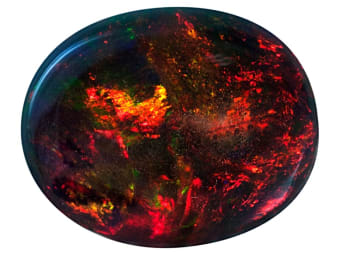
Healing Properties and Benefits of Opal
Opals as a whole are said to strengthen the memory of the holder. Many believe that October's birthstone can be beneficial for the eyes, kidneys and skin.
Black opals are said to be suitable for breaking down densities in the body - such as tumors and cysts.
People believe that white opals can strengthen the skin, hair and nails. So, this gem is perfect for those who suffer from eczema (if you believe in the healing power of stones).
Colors of Opal
Opal can be transparent (see-through), translucent (glassy) or opaque (cloudy). Opal comes in a rainbow of colors. In fact, boulder opals can have every color of the rainbow in just one gem. That’s seven different colors - but don't worry, they don't have to fight for attention because they naturally blend so well together.
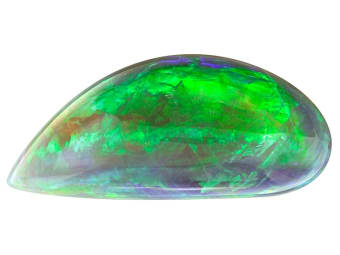
Opal color variety:
- Purple
- Gray
- Brown
- Blue
- Orange
- Pink
- Green
- Red
- White
- Black
- Multi-colored
But where does opal get its amazing color from? The play-of-color you see when admiring opal is due to millions of tiny spheres made of silica that are each different sizes. Each silica sphere refracts light, which causes the spectral colors you see.
Amazingly, each sphere has to be just the right size and be uninformed enough to create enough color for your eyes to see. This unique formation of silica spheres gives opal with the ability to express every color of the rainbow.
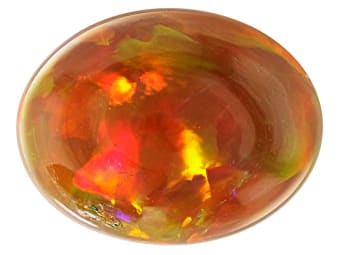
Did you know... Play-of-color is a term used to describe the multi-dimensional color patterns that are unique to precious opal?
Opal Birthstone Jewelry and Gifts

Opal October Birthstone Jewelry Buyers' Guide
Hey, October babes! If you’re born in October, you are lucky enough to have the mystical opal as your galaxy-dream birthstone. Opal comes in every color of the rainbow, which pairs with any look. So, treat yourself to a rainbow of color.
Good news! Have you ever heard the rumor that if you wear opal and you weren’t born in October, it’ll bring bad luck? Well, it’s just a work of fiction. Anyone can enjoy the beautiful, stunning looks of opal. Shop some color sophistication with opal necklaces, rings, bracelets and more today!
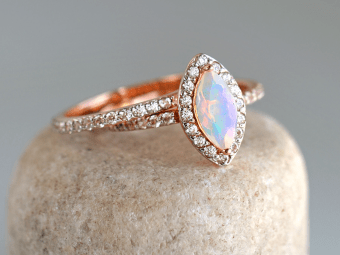
Did you know... Opals are often left in their natural state - unlike other gemstones on the market?
October Birthstone Alternatives
Pink tourmaline
Don't be fooled, even though this gorgeous pink gemstone is found all over the world; pink tourmaline is still very rare. Pink tourmaline is thought to encourage love and compassion during periods of human growth.
Dutch Traders of the 1700s would use pink tourmaline to remove ash from their smoking pipes. How? If you rub or heat pink tourmaline, it can become electrically charged. One side of the gem becomes positive and the other negative, attracting particles of dust or bits of paper.
Pink tourmaline ranks a 7 on the Mohs scale. So if you want to boast your October pride, but want a gem that's a little more durable - pink tourmaline is a great alternative to the traditional opal.
